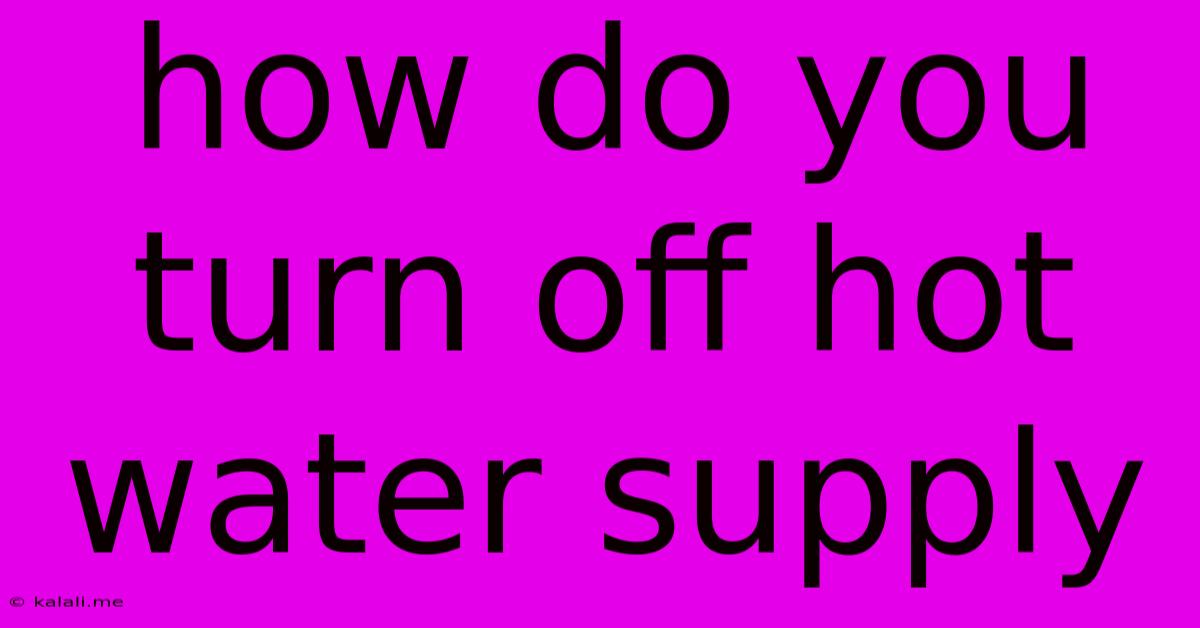How Do You Turn Off Hot Water Supply
Kalali
May 20, 2025 · 3 min read

Table of Contents
How to Turn Off Your Hot Water Supply: A Step-by-Step Guide
This guide provides a comprehensive walkthrough on how to turn off your hot water supply, covering various scenarios and safety precautions. Knowing how to shut off your hot water is crucial for emergencies like leaks, repairs, or preventing further damage. This is an essential skill for every homeowner.
Why Turn Off Your Hot Water?
There are several reasons why you might need to turn off your hot water supply. These include:
- Leaks: A dripping faucet or burst pipe can lead to significant water damage. Shutting off the water prevents further problems.
- Repairs: Any plumbing repairs involving hot water lines require turning off the supply to prevent scalding and flooding.
- Maintenance: Regular maintenance of your water heater may necessitate turning off the hot water.
- Frozen Pipes: In freezing temperatures, shutting off the water can help prevent pipe bursts.
Locating Your Hot Water Shut-Off Valves:
The location of your hot water shut-off valves depends on your plumbing system. There are typically two main places to find them:
- Water Heater: The most straightforward place is the shut-off valve located directly on your water heater. This valve controls the entire hot water supply to your home.
- Main Water Supply: Your main water shutoff valve (usually located near the water meter) can also be used, but this cuts off both hot and cold water to your entire house. This is a last resort option.
Identifying Your Valves:
Hot water shut-off valves are usually similar in appearance to cold water valves, often a ball valve or a gate valve. They're often marked with "Hot" or a red handle. If unsure, carefully check nearby pipes to confirm.
Step-by-Step Instructions for Turning Off Your Hot Water Supply:
- Locate the Valve: First, identify the hot water shut-off valve closest to the source of the problem or your water heater.
- Prepare for Potential Mess: Place towels or a bucket underneath the valve to catch any dripping water.
- Turn the Valve: Most valves turn clockwise to close (shut off the water). Some valves, however, may operate in reverse. Turn the valve slowly and steadily until it stops. You might hear a slight click or feel resistance as the valve closes.
- Check for Leakage: After turning the valve, check carefully for any leaks around the valve itself. If you notice leakage, consider tightening the valve slightly more. If leakage persists, consult a professional plumber.
- Test the Hot Water: Turn on a hot water tap somewhere in your home to confirm the hot water supply is off.
Types of Valves and Their Operation:
- Ball Valves: These are typically quarter-turn valves. A 90-degree turn will either fully open or close the valve.
- Gate Valves: These require a more gradual turning motion to open or close fully.
Important Safety Precautions:
- If unsure, call a professional plumber. Attempting repairs without proper knowledge can lead to further damage or injury.
- Always turn off the water slowly and carefully. Forcing a valve can damage it.
- Use caution when working with plumbing. Be aware of potential hazards like hot water or sharp objects.
- Turn off the electricity to the water heater before performing any major maintenance or repairs.
By following these steps, you'll be able to confidently turn off your hot water supply in any situation requiring it. Remember, knowing how to do this can save you from significant water damage and costly repairs. Always prioritize safety and call a professional if you're unsure about any aspect of this process.
Latest Posts
Latest Posts
-
How Old Was Jesus When Magi Came
May 21, 2025
-
How Do You Remove Permanent Marker From Wood
May 21, 2025
-
What Does Dirty Mean In A Martini
May 21, 2025
-
How To Fix A Creaking Wooden Bed Frame
May 21, 2025
-
Road Sign Red Cross On Blue Background
May 21, 2025
Related Post
Thank you for visiting our website which covers about How Do You Turn Off Hot Water Supply . We hope the information provided has been useful to you. Feel free to contact us if you have any questions or need further assistance. See you next time and don't miss to bookmark.